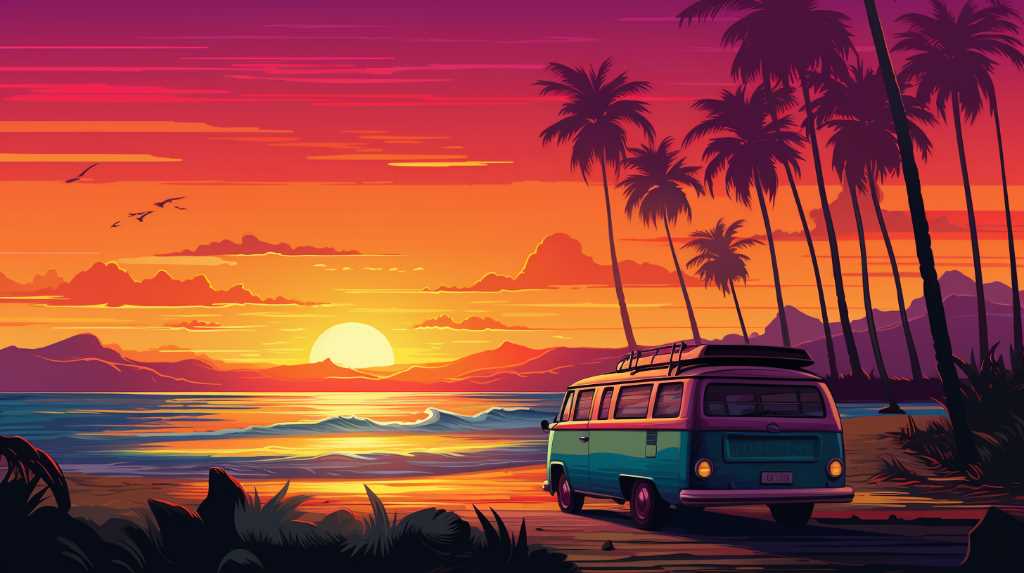
Modern surf music has changed a lot since it started in the 1960s. It was first popular among surfers in Southern California. Now, the music has grown and changed by taking in different styles. This has made surf music more interesting and it now reaches a wider audience. Many bands have been important in changing surf music by mixing old styles with new ideas. They use different instruments and new ways of playing music. This has helped surf music become popular all over the world and not just in one place.
When we look at surf music today, we can see how it reflects what’s going on in the world. It shows us how music can keep changing and still stay true to its roots. For example, bands like The Growlers and La Luz take the classic surf sound and make it new, which shows how music can evolve while still keeping its original spirit. These bands use catchy guitar riffs and a mix of modern and traditional instruments to create a new kind of surf music.
This shows that surf music is still going strong and is as meaningful today as it was when it first started.
Origins and Evolution
Surf music started in the early 1960s in Southern California. This music, full of energy, became the signature sound for the area’s growing love for surfing. The music is known for its loud electric guitars with a lot of echo, fast beats, and themes about the beach. It really showed what it was like to enjoy life by the ocean.
Bands such as The Beach Boys and Dick Dale & The Del-Tones were at the forefront of this music style. They mixed rockabilly, jazz, and unique guitar sounds to capture the excitement of surfing. This mix of music and surfing lifestyle created a type of music that spoke to the sense of freedom and adventure that comes with surfing.
As more people around the world started to surf, the music also changed, taking in new styles but keeping its original feel.
Key Influential Bands
Several bands have left an indelible mark on the surf music scene, setting the stage for a genre that reverberates with the spirit of coastal freedom and innovation.
The Beach Boys, with their lush vocal harmonies and depictions of Californian beach culture, propelled surf music into global consciousness.
Meanwhile, Dick Dale’s pioneering use of rapid alternate picking and his thunderous, reverb-soaked Fender Stratocaster crafted the very sound waves that would define instrumental surf rock.
The Ventures, with their crisp guitar tones and catchy melodies, further shaped the genre’s aesthetic while inspiring a multitude of garage bands.
These key influencers not only encapsulated the surf music ethos but also infused it with a sense of perpetual youth and sun-drenched escapism that continues to resonate in modern iterations.
Instrumentation and Techniques
In modern surf music, the use of electric guitars is key. These guitars have a unique sound that includes sharp twangs and quick dips, thanks to a tool called a whammy bar. While musicians today keep the classic feel of surf music alive, they also mix in new sounds. They do this by using old-style Fender guitar effects combined with newer sound pedals. This mixture creates a rich sound that respects the history of surf music but also brings in something new.
The way guitarists pick their strings is also important. They do it in a way that mimics the waves of the ocean, which is a big part of what makes surf music special. Drummers add to this feeling by playing their drums in a certain way – quick hits on the snare drum and careful use of the cymbals called hi-hats make you think of the sound of waves crashing.
As surf music changes over time, it keeps a balance between honoring its roots and trying out new ideas. This balance makes the music stand out. For example, if you want to get that classic surf guitar sound, you might use a Fender reverb unit or a spring reverb pedal like the Boss FRV-1. These tools help create the deep, echoing sounds that surf music is known for.
Global Scene and Diversity
The worldwide reach of surf music shows how different cultures have adopted and changed it, making the genre even more interesting. Now, surf music isn’t just heard in California; it’s played on Australian beaches and in Japan, mixing local sounds and styles. This mixing adds new layers to the music, as musicians combine the classic surf guitar sound with their own traditional instruments and beats, creating something both recognizable and new.
Surf music’s ability to change and grow is clear when you look at how it’s played around the world. You can hear the old-school surf vibe from the ’60s, but now there’s also a mix with other types of music like indie, punk, and even electronic. This shows that surf music is flexible and keeps changing as new artists bring their ideas to it. They respect the history of surf music while also exploring new directions in sound.
Let’s consider a specific example: ‘The Atlantics’ from Australia, who brought the surf rock genre to life with their hit ‘Bombora,’ demonstrate the global influence by merging traditional surf rock with their unique Australian character. Similarly, ‘Shonen Knife’ from Japan infuses surf rhythms with punk energy, adding a fresh twist to the classic surf sound. These bands illustrate how the genre can evolve and still stay true to its roots.
Surf Music in Popular Culture
Surf music has had a big impact on popular culture. It’s known for its cheerful, easygoing vibe that reminds us of the beach and youthfulness. This type of music, with its distinctive guitar sounds and lively beats, is heard in movies, TV shows, and ads. It represents the fun and freedom of beach life and makes people think of the 1960s in the United States.
The popularity of surf music hasn’t faded. It’s often used in new music either directly or as an inspiration. This shows that its appeal hasn’t gone away over the years. Also, places known for their beaches often use surf music to help create their image. This music helps to shape how we think about and imagine beach settings.
In short, surf music is still a big part of our culture. It captures the essence of the beach lifestyle and continues to be used to set the mood in various media, keeping the spirit of the 1960s alive.
Conclusion
Surf music is known for its echoey guitar sounds and lively beats. It started by the sea but now people all over the world enjoy it. This kind of music has changed over time, showing that it’s flexible and its style has spread into other types of music we hear today. People keep loving surf music because it has a special sound and reminds us of its interesting history. It makes people feel good by bringing back the fun memories of the past, and even now, younger folks are getting into it.
Here’s what’s cool about surf music: it’s got this unique guitar sound where it feels like the notes are bouncing back at you, kind of like an echo. This is called ‘reverb,’ and it’s a big part of what makes surf music sound like the beach. Plus, the beats are usually pretty peppy, making you want to dance or tap your foot.
Even though surf music started out near the ocean, it didn’t stay there. It’s all over the place now, from movies to different styles of songs that lots of us listen to without even realizing it. It’s like when you hear a song in a commercial and can’t help but groove to it — that’s the influence of surf music right there.
But why do people still care about it after all this time? Well, it’s not just about the music itself; it’s also about the story behind it. Surf music takes us back to a cool time in history, like the 1960s in California, when surfing was super popular. When we hear surf music, we think of that time, the beach, and all the fun that came with it. It’s kind of like when you smell something that reminds you of your favorite vacation.
For those who are curious and want to dive into surf music, there’s a lot to explore. You could check out classic bands like The Beach Boys or newer ones that keep the spirit alive. And if you’re a musician, you might want to try adding some reverb to your guitar playing and see if you can get those waves rolling.
In a nutshell, surf music’s got a timeless vibe that keeps everyone from grandparents to kids bopping along. It’s like a musical wave that’s been riding strong for decades, and it doesn’t look like it’s crashing down anytime soon.








